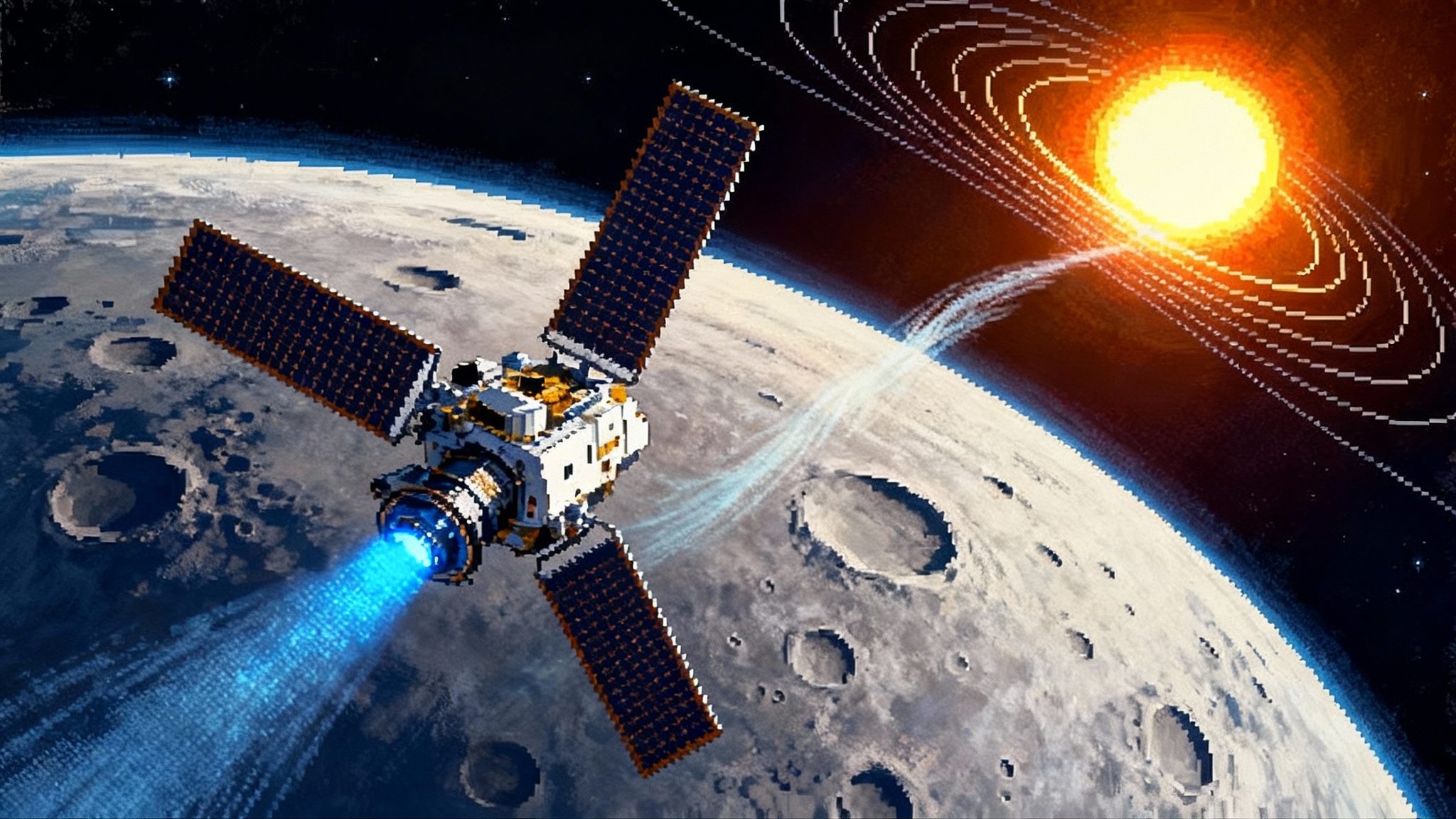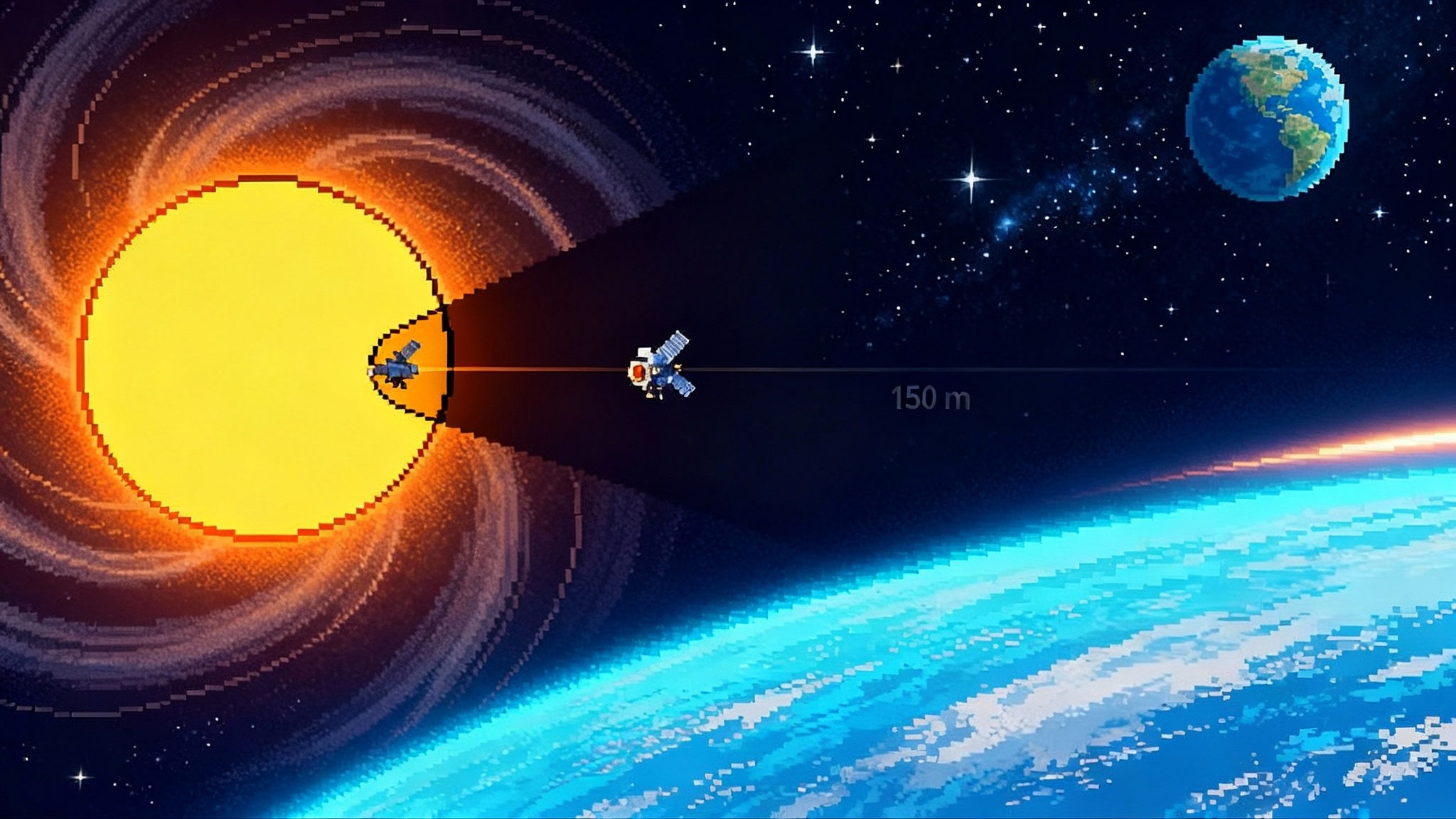BepiColombo’s reroute sets up a richer Mercury campaign
ESA’s BepiColombo will now target Mercury orbit in November 2026 after a thruster power shortfall. The reroute preserves core goals, adds rich flyby science, and times the main campaign with an active Sun that could supercharge magnetosphere and exosphere results.

Breaking: a later arrival that improves the science
On Sept. 2, 2025 the European Space Agency confirmed that BepiColombo’s electric thrusters cannot deliver their planned power, which forces a new flight plan and pushes Mercury orbit insertion to November 2026. ESA’s flight dynamics team has shifted the spacecraft onto a trajectory that preserves the core science objectives while easing the propulsion demands, a change detailed in ESA’s Sept. 2 mission update. The headline sounds like a setback. Look closer and you see an opportunity. Arriving during the still lively phase of Solar Cycle 25 gives Europe’s twin orbiters an unusually energetic Mercury to study.
BepiColombo is a joint European and Japanese mission composed of two spacecraft that will separate in Mercury orbit. ESA’s Mercury Planetary Orbiter will fly low and steady to map the planet’s surface and interior. JAXA’s Mio, the Mercury Magnetospheric Orbiter, will take a higher and more elliptical path to sample the planet’s magnetic bubble and the torrent of charged particles from the Sun. The delay keeps these two roles intact, but it changes when the pair start the main act. That timing shift matters because Mercury becomes a better laboratory when the Sun is fidgety.
Why the thruster shortfall happened, in plain terms
BepiColombo’s cruise stage uses solar electric propulsion. Think of it as a patient, continuous push from a quiet engine. Instead of a strong shove from a chemical rocket, ion thrusters fire for weeks and months, adding speed gently but relentlessly. To do that work, the Mercury Transfer Module converts sunlight into electrical power for four ion engines and then into thrust using xenon propellant.
Engineers traced this year’s performance drop to unwanted currents between the cruise stage’s solar array and a power distribution unit. The result is less electrical power available for the thrusters. Less power means less thrust. With the original plan, BepiColombo needed a specific minimum push to fall into Mercury orbit in December 2025. The new plan reduces the propulsion burden during cruise and shifts the capture date to November 2026. Reports have also noted that teams recovered much of the lost performance but not enough to meet the original insertion window, a point covered in a SpaceNews report on the thruster shortfall.
A compact metaphor helps: picture a cyclist planning to crest a hill before sunset. A headwind kicks up and the rider cannot sustain the intended pace. The smart move is to adjust the route and arrival time, ride a gentler grade, and still reach the destination with energy to spare. ESA’s approach mirrors that choice.
The route change and what it buys the mission
The revised path uses Mercury flybys more strategically, wringing extra change in speed and direction from each passage. A slightly closer fourth flyby helped reduce the thrust needed before the fifth, and the sixth set the spacecraft on the new long arc toward capture. By shifting the workload from engine to gravity, the team can keep propellant margins and avoid risky, high-power burns.
Science also benefits from a cruise that leans on gravity. Extended flybys are not just navigational tricks. Instruments on both orbiters can operate during the passes, collecting snapshots of magnetic fields, plasma, and the thin exosphere as the spacecraft threads different latitudes and local times. Those glimpses become a preview of how the system behaves across seasons and solar-weather conditions.
Solar Cycle 25 is the unplanned ally
Solar cycles last about eleven years, with peaks that keep aurora forecasters and space-weather teams busy. Forecasts put the crest of Solar Cycle 25 in the 2024 to 2026 window, with elevated activity likely to linger into 2026 and 2027. For a mission built to study how a small planet holds onto a magnetic field and how the solar wind scours its surface, this is ideal. For a closer look at the Sun’s behavior near maximum, Proba-3’s on-demand eclipses show how the inner corona that seeds space weather is mapped.
When the Sun spits out flares and coronal mass ejections, Mercury sits in the front row. The planet has a global magnetic field, but its protective bubble is compact. Solar storms can squeeze and rattle Mercury’s magnetosphere, open cracks in magnetic field lines, and dump charged particles deep into the system. That commotion does two things that are great for science. First, it increases the signal on instruments that measure magnetic fields and charged particles. Second, it changes the surface-exosphere chemistry in real time, letting instruments watch how atoms like sodium are knocked off the surface, lofted, and lost.
The new arrival date keeps BepiColombo’s main campaign nestled in that active stretch. Instead of tiptoeing in at the tail end of the cycle, the mission meets Mercury while the Sun still has energy to spare.
Two orbiters, one story: how the tandem will map the planet from core to sky
BepiColombo’s design is a study in complementary views.
-
Mercury Planetary Orbiter: This spacecraft will fly a low polar orbit, circling Mercury every couple of hours. The payload looks inward as much as it looks down. A laser altimeter will map topography and limb profiles. An X-ray and gamma ray suite will probe elemental composition. A thermal infrared radiometer will pinpoint rock types and track how the surface breathes heat each Mercury day. A radio science experiment will use tiny wobbles in the spacecraft’s path to map gravity variations, which reveal the thickness of the crust, the strength of tidal flexing, and the size and state of the core. A magnetometer will sample the planet’s magnetic field from close range and separate internal signals from external ones.
-
Mio, the Mercury Magnetospheric Orbiter: This spinning spacecraft will trace an elongated path that reaches far into the magnetosphere. Its magnetometer will map field lines and reconnection events. Particle instruments will count and characterize electrons and ions from the solar wind and from the planet’s own plasma sources. A plasma wave package will listen for the crackle of energy as fields and particles interact. A sodium imager will monitor the exosphere’s faint glow, especially during storms. A dust monitor will track micrometeoroid hits that feed the exosphere.
Together they tackle one central question: how can a small, iron-rich world that bakes in sunlight sustain a magnetic field, and what does that field do to protect or erode its environment? Comparative campaigns such as ESCAPADE’s magnetosphere playbook at Mars show how coordinated spacecraft can untangle planetary signals from solar-wind noise.
Cracking Mercury’s magnetic heart
Mercury’s magnetic field is weak compared with Earth’s, but it exists, and that is a puzzle. Dynamo theory says molten metal moving in a convecting core can generate a field. Mercury is small, so it should have cooled quickly. The evidence suggests otherwise. BepiColombo’s radio science and altimetry will track how the planet flexes under the Sun’s gravity. The degree of flexing constrains how squishy the interior is. If the core is at least partly molten, the planet will bulge and relax in a way that precise tracking can measure.
Meanwhile, the magnetometers on both orbiters will separate the planet’s internal field from the external swirls of the magnetosphere. By flying in different orbits at the same time, the spacecraft can subtract space-weather noise from the planetary signal. That lets scientists estimate the depth and vigor of the dynamo and how it changes with time and solar forcing.
One practical payoff is calibration. If the mission can tie specific wobbles in the field to tides in the molten core, then those measurements become a yardstick for other rocky worlds. We would know what a young or tired dynamo looks like when it sits next to a lively star.
Exosphere alchemy in a stormy season
Mercury does not have a thick atmosphere. It has a fragile exosphere, a ghostly veil of atoms knocked off the surface by photons, micrometeoroids, and charged particles. During solar storms, this veil brightens and shifts shape as sodium, potassium, and other atoms are dredged up and pushed tailward by radiation pressure.
BepiColombo’s exosphere and plasma instruments will watch these changes at high cadence. The goal is not just to count atoms. It is to trace the whole cycle. How many atoms are released by a meteor stream or a sudden solar blast. How fast do they escape. How quickly do they settle back. Those measurements tell scientists how fast a star can weather a rocky world and how a magnetic field moderates that assault.
The timing helps. With the Sun still popping off frequent eruptions, the mission will collect many examples rather than a handful. More events mean better statistics and cleaner correlations between cause and effect.
The budget picture: volatility, tradeoffs, and the value of time
BepiColombo has been a difficult program, with a long development and a complex cruise architecture. Historic figures from the mid-2010s put the European Space Agency’s share around the one to one-and-a-quarter billion euro range for spacecraft, launch, cruise, and initial operations, with additional contributions from national agencies for instruments and a significant investment by JAXA for Mio. The new trajectory extends cruise operations by roughly a year. That usually adds costs for mission control staffing, network time on deep space antennas, and periodic instrument activities.
Three practical takeaways matter for readers who track program risk and finance:
- Operations extensions are not simple calendar slips. They add recurring costs that are small next to development but meaningful for a constrained science budget. Managers must program that money years ahead and keep it flexible.
- Workarounds can be cheaper than repairs in deep space. Once a root cause points to a structural limitation in power or thermal margins, changing the trajectory and timeline often reduces risk compared with pushing hardware to its limit.
- Data value is a function of context as well as quantity. Arriving during an active solar season can multiply the scientific return without changing a single instrument. In economic terms, the delay can improve the benefit side of the cost-benefit ledger.
For policymakers, one clear action stands out: fund mission operations contingency at the portfolio level rather than mission by mission. That lets a program like BepiColombo borrow a small amount of flexibility when a clever trajectory change preserves the core science. Portfolio contingency is cheaper than emergency appropriations and better than starving other missions when a single project needs a little more time. Program management lessons echo those from Dragonfly’s CDR milestone, where schedule realism and risk burn-down shape science return.
What this means for Mercury-like exoplanets
We cannot yet fly probes to rocky exoplanets orbiting other stars, but we can use Mercury as a reference world. Many small exoplanets circle close to their stars, where radiation is intense and space weather is fierce. Some likely have thin atmospheres or just a surface-bounded exosphere. A few may have magnetic fields that fight a losing battle against the stellar wind.
BepiColombo’s measurements will sharpen this picture in three specific ways:
- Interior templates: Gravity and tidal data that constrain Mercury’s core size and state give theorists a realistic menu of interior structures for close-in rocky planets. When we see a planet’s mass and radius from telescopes, we can plug those values into models that include Mercury-like layering rather than idealized spheres.
- Magnetic survival curves: Joint magnetometer data will tell us how a small dynamo behaves when a star keeps hammering it. That becomes a survival curve for magnetic fields as a function of planet size, composition, and stellar activity. With that curve, observers can interpret signatures like star-planet magnetic interactions and radio bursts with fewer assumptions.
- Escape chemistry: Exosphere observations during storms will quantify how quickly different elements and molecules are sputtered, lofted, and lost. Those rates feed directly into models of atmospheric escape on hot terrestrial exoplanets. When telescopes catch sodium or calcium around a distant world, we will have a grounded comparison from our own backyard.
A decade from now, when more powerful observatories deliver sharper spectra of close-in rocky planets, the fingerprints BepiColombo collects will make those distant signals easier to decode.
A quick instrument tour, with a focus on how each closes a gap
- Laser altimetry and imagery: High resolution topography and imaging will reveal tectonic features and fault scarps. These features, along with crater counts, set the clock on Mercury’s cooling. That indirectly constrains how long its core stayed molten.
- Thermal infrared and X-ray spectroscopy: These instruments will map minerals and elemental abundances. Differences in surface composition across latitudes and terrains will test theories about how Mercury formed, including whether it was hit by a giant impact that stripped away crustal material.
- Radio science: Tiny changes in the spacecraft’s radio signal trace gravity anomalies and tides. These data turn into profiles of density versus depth and estimates of core composition.
- Magnetometers and plasma instruments on both orbiters: Flying in different orbits at the same time lets the team separate signals from the planet and the space environment. That is how you turn a messy magnetic neighborhood into a clean map of an internal field.
- Exosphere sensors and sodium imaging: These reveal the breath of the planet as the Sun tugged and meteoroids peppered the surface. Watching the exosphere surge during storms turns space weather into a natural experiment.
Each payload element ties to a specific uncertainty in today’s models. None is redundant, and several only reach full value when the Sun is lively.
What to watch between now and November 2026
- Cruise and flyby operations: Expect occasional instrument activations during the long arc to capture more magnetosphere snapshots. Those data are appetizers, and they help refine calibrations.
- Health checks and power management: The team will continue to manage power margins while keeping thruster performance stable. The goal is a clean separation and capture phase with comfortable reserves.
- Science planning for an active Sun: Teams will tune observing plans for storm seasons, including coordinated campaigns between the two orbiters and ground-based observers that track Mercury’s sodium tail.
- The handoff to Mercury orbit: The choreography of separating the transfer module, deploying booms and antennas, and easing each orbiter into its science orbit will be intricate. Smooth execution sets the tone for a high cadence first year.
The bottom line
A propulsion shortfall is never good news. Yet the way ESA and JAXA have responded turns a delay into a sharper experiment. With arrival shifted to November 2026, BepiColombo enters the scene while the Sun is still feisty. The twin orbiters are built for exactly that environment. If you care about how rocky planets hold onto magnetic fields, how space weather sculpts airless worlds, and how to read the signatures of Mercury-like exoplanets, the new plan is not just acceptable. It is promising.
Smart space programs make constraints work for them. BepiColombo’s reroute is a case study in that craft: alter the path, keep the goals, and meet the planet at the moment it has the most to teach.








